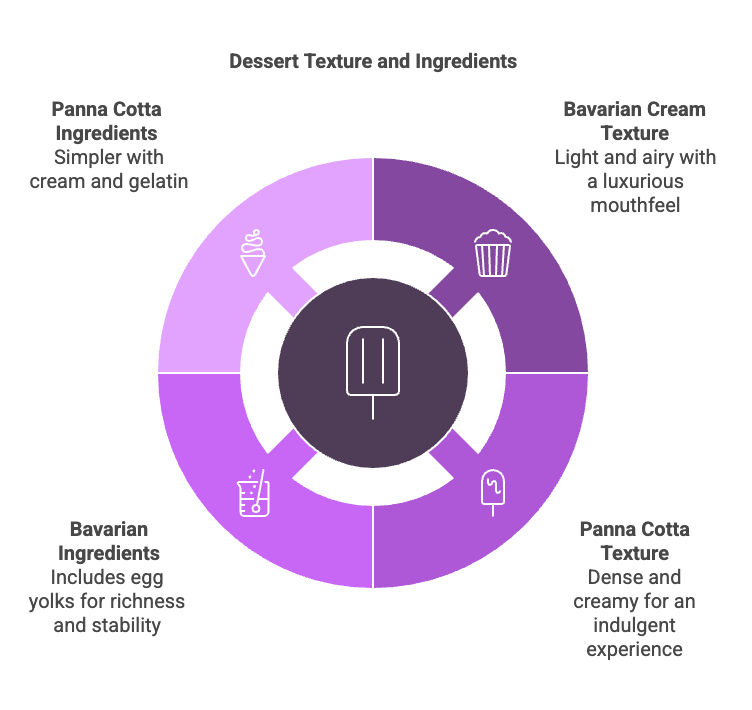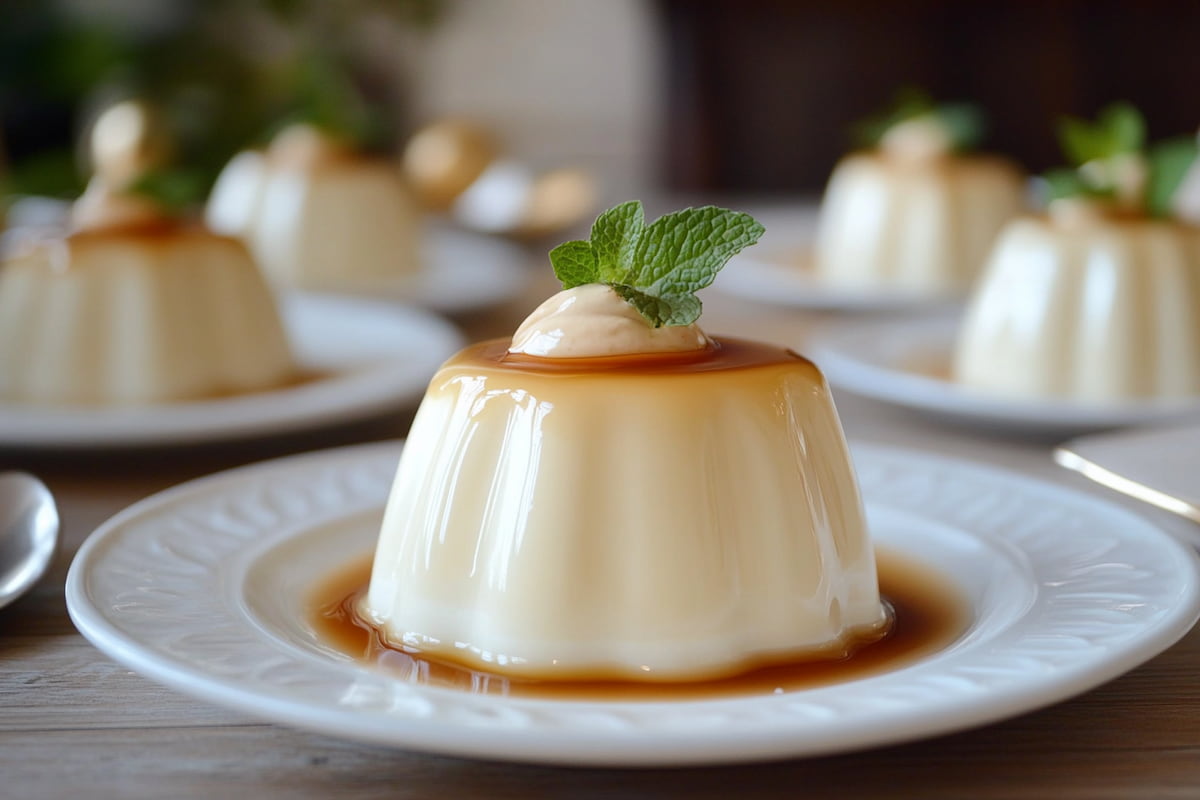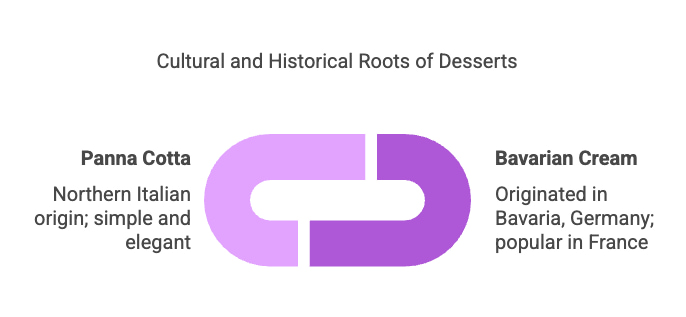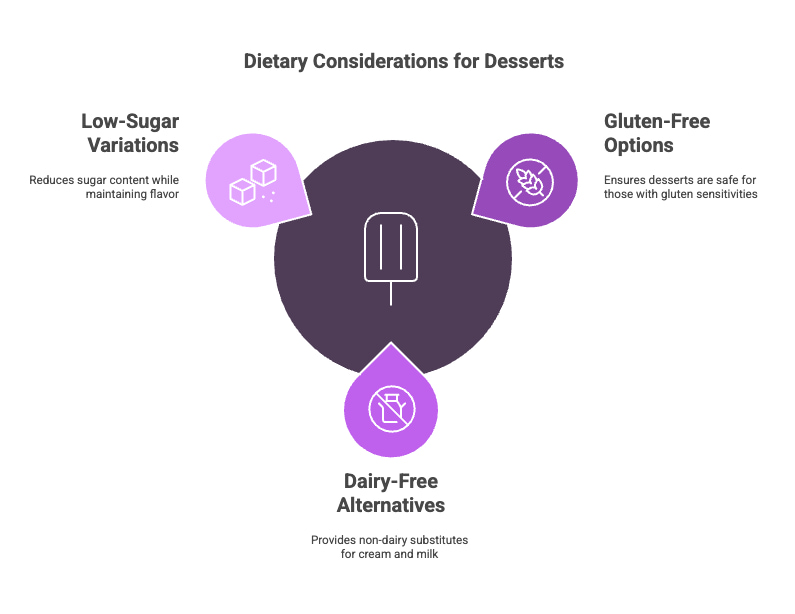When it comes to creamy, dreamy desserts, Bavarian cream and panna cotta often steal the spotlight. However, are they really the same? This question has puzzled dessert lovers for ages. In this article, we’ll dive deep into the world of these two delightful treats, exploring their histories, ingredients, and preparation methods. So, grab a spoon, and let’s dig in!
Overview of Bavarian Cream and Panna Cotta
Bavarian cream, or crème bavaroise, is a classic French dessert from the 19th century. It’s known for its rich, velvety texture and is typically flavored with vanilla, chocolate, or fruit. The base is made from a mixture of cream, sugar, eggs, and gelatin, which gives it that iconic jiggle. Furthermore, Bavarian cream is often served chilled, making it a refreshing option for warm days.
Panna cotta, on the other hand, is an Italian dessert that translates to “cooked cream.” It is simpler to prepare but equally delicious. Made primarily from cream, sugar, and gelatin, panna cotta can be flavored with various ingredients, such as vanilla, coffee, or fruit puree. Consequently, it’s typically served in molds, allowing for beautiful presentations that can impress any dinner guest.
Key Differences Between Bavarian Cream and Panna Cotta
Now that we’ve introduced both desserts let’s examine the key differences between Bavarian cream and panna cotta. Understanding these distinctions will help you appreciate each dessert’s unique qualities.
Texture and Consistency of Bavarian Cream vs. Panna Cotta
One of the most noticeable differences between Bavarian cream and panna cotta is their texture. Bavarian cream is light and airy, thanks to the whipped cream folded into the mixture. This gives it a luxurious mouthfeel that melts in your mouth. On the other hand, panna cotta has a denser, creamier consistency, making it feel more indulgent.
Ingredients Used in Bavarian Cream and Panna Cotta
While both desserts use similar ingredients, the proportions and additional components set them apart. Bavarian cream often includes egg yolks, which contribute to its richness and stability. In contrast, panna cotta relies primarily on cream and gelatin, making it a bit simpler to prepare. Therefore, if you’re looking for a quick dessert, panna cotta might be your best bet.

Exploring the History of Bavarian Cream and Panna Cotta
To fully appreciate Bavarian cream and panna cotta, it’s essential to understand their historical backgrounds. Both desserts have rich culinary traditions that reflect their cultural origins.
The Origins of Bavarian Cream
Bavarian cream traces its roots back to Bavaria, Germany; however, it gained popularity in France during the 19th century. The dessert was created by chefs who sought to impress the aristocracy with its luxurious texture and flavors. Interestingly, Bavarian cream was often served as a showpiece at grand banquets, showcasing the chef’s skill and creativity.
Over time, Bavarian cream evolved, incorporating various flavors and ingredients. In addition, today, it remains a staple in French patisserie, often enjoyed at special occasions and celebrations. Its versatility allows for endless variations, making it a favorite among dessert enthusiasts.
The Italian Heritage of Panna Cotta
Panna cotta has a simpler yet equally fascinating history. Originating from the northern regions of Italy, this creamy dessert was traditionally made by using leftover cream from the production of butter. The name “panna cotta” literally translates to “cooked cream,” reflecting its straightforward preparation method.
In its early days, panna cotta was often flavored with local ingredients, such as vanilla or fruit. As it gained popularity, chefs began experimenting with different flavors and presentations. Consequently, today, panna cotta is celebrated worldwide for its simplicity and elegance, making it a beloved dessert in Italian cuisine.
 Flavor Pairings for Bavarian Cream and Panna Cotta
Flavor Pairings for Bavarian Cream and Panna Cotta
One of the joys of making these desserts is the opportunity to experiment with flavors. Let’s explore some delightful pairings that can elevate your desserts to the next level.
Fruits and Berries with Bavarian Cream and Panna Cotta
Fresh fruits and berries are a fantastic way to enhance the flavors of both desserts. Consider pairing Bavarian cream with:
- Strawberries
- Raspberries
- Blueberries
- Mango slices
For panna cotta, you can also use fruit compotes or purees, such as:
- Passion fruit
- Pineapple
- Peach puree
- Cherry sauce
These fruity accompaniments add flavor and provide a beautiful contrast in color and texture, making your desserts visually appealing.
Chocolate and Caramel Pairings for Bavarian Cream and Panna Cotta
For those with a sweet tooth, chocolate and caramel are excellent choices. Bavarian cream can be enhanced with:
- Chocolate ganache
- Cocoa powder for a chocolate version
- Caramel sauce drizzled on top
Panna cotta pairs wonderfully with:
- Dark chocolate shavings
- Salted caramel sauce
- Chocolate mousse
These rich flavors create a decadent experience that will satisfy any dessert lover.
Serving Suggestions for Bavarian Cream and Panna Cotta
Presentation matters when it comes to desserts. Here are some creative serving suggestions that will wow your guests.
Elegant Glasses and Molds for Bavarian Cream and Panna Cotta
Both Desserts can be served in elegant glasses or molds. Consider using:
- Stemless wine glasses for a modern touch
- Classic ramekins for a traditional look
- Silicone molds for fun shapes
Layering the desserts with fruit or sauces in clear glasses allows the beautiful textures and colors to shine through.
Garnishes and Toppings for Bavarian Cream and Panna Cotta
Don’t forget the garnishes! A well-placed garnish can elevate your dessert from simple to stunning. Here are some ideas:
- Fresh mint leaves for a pop of color
- Edible flowers for a touch of elegance
- Chopped nuts for added crunch
- Whipped cream dollops for extra indulgence
These finishing touches not only enhance the visual appeal but also add flavor and texture to your dessert.
Dietary Considerations and Alternatives for Bavarian Cream and Panna Cotta
As more people become health-conscious, it’s essential to consider dietary alternatives when preparing desserts. Here are some options for those looking to enjoy Bavarian cream and panna cotta while adhering to specific dietary needs.
Gluten-Free Options for Bavarian Cream and Panna Cotta
Both desserts are naturally gluten-free, making them suitable for those with gluten sensitivities. However, always check the labels on your ingredients to ensure they are certified gluten-free, especially if you’re using pre-packaged items.
Dairy-Free Alternatives for Bavarian Cream and Panna Cotta
If you’re lactose intolerant or following a dairy-free diet, you can still enjoy these desserts! Consider using:
- Coconut cream instead of heavy cream
- Almond milk or cashew milk for a lighter option
- Aquafaba (the liquid from canned chickpeas) as an egg substitute for thickening
These alternatives can provide a similar texture and flavor profile, allowing everyone to indulge in these delicious desserts.
Low-Sugar Variations for Bavarian Cream and Panna Cotta
For those watching their sugar intake, there are several ways to reduce the sweetness of Bavarian cream and panna cotta. Here are some tips:
- Use natural sweeteners like stevia or erythritol.
- Reduce the amount of sugar in the recipe by 25% without sacrificing flavor.
- Incorporate naturally sweet ingredients, such as ripe bananas or applesauce, to enhance sweetness without added sugar.
These adjustments can help you create delicious desserts that fit your dietary preferences.
Common Mistakes to Avoid
Even the most seasoned bakers can make mistakes. Here are some common pitfalls to avoid when making these desserts:
Overheating the Cream for Bavarian Cream and Panna Cotta
When heating the cream, do not bring it to a boil. Boiling can cause the cream to separate and alter the texture of your dessert. Instead, heat it gently over medium-low heat, stirring frequently.
Improper Gelatin Usage in Bavarian Cream and Panna Cotta
Gelatin is a key ingredient in both desserts, and it is vital to use it correctly. Always bloom gelatin in cold water before adding it to the warm cream mixture. This step ensures that it dissolves evenly and prevents lumps.
Skipping the Chilling Time
Patience is essential when making these desserts. Skipping the chilling time can result in a runny consistency. Therefore, make sure to refrigerate the desserts for the recommended time to allow them to set properly.
Creative Variations
While traditional Bavarian cream and panna cotta are delicious on their own, experimenting with variations can lead to exciting new flavors and textures. Let’s explore some creative twists on these classic desserts.
Flavored Bavarian Cream Variations
Bavarian cream is a versatile base that can easily accommodate various flavors. Here are some delightful variations to try:
- Chocolate Bavarian Cream: Incorporate melted dark chocolate into the cream mixture for a rich, indulgent treat.
- Fruit-Infused Bavarian Cream: Puree fresh fruits like strawberries or mangoes and fold them into the mixture for a fruity twist.
- Coffee Bavarian Cream: Add brewed espresso or coffee extract for a delightful caffeine kick.
- Matcha Bavarian Cream: Mix in matcha powder for a unique flavor and vibrant green color.
These variations not only add exciting flavors but also allow you to showcase seasonal ingredients.
Unique Panna Cotta Flavors
Panna cotta can also be transformed with various flavorings. Here are some ideas to inspire your next creation:
- Lavender Panna Cotta: Infuse the cream with dried lavender for a floral aroma and taste.
- Coconut Panna Cotta: Substitute coconut milk for some of the cream for a tropical twist.
- Spiced Panna Cotta: Add spices like cinnamon or cardamom to the cream for a warm, comforting flavor.
- Citrus Panna Cotta: Incorporate lemon or orange zest for a refreshing citrusy note.
These unique flavors can turn a classic panna cotta into a standout dessert that surprises and delights your guests.
Hosting a Dessert Tasting Party
If you’re feeling adventurous, consider hosting a dessert-tasting party featuring Bavarian cream and panna cotta. Here’s how to make it memorable:
Setting the Scene for Your Dessert Tasting
Soft lighting and comfortable seating create a cozy atmosphere. Consider using decorative plates and glasses to enhance the presentation of your desserts. A beautiful setup can make your guests feel special and excited about the tasting.
Curating a Dessert Menu
Prepare a selection of both desserts’ variations, allowing your guests to sample different flavors. You might include:
- Classic vanilla Bavarian cream
- Chocolate and raspberry panna cotta
- Mango Bavarian cream with fresh fruit
- Lavender panna cotta with honey drizzle
Providing a variety ensures that there’s something for everyone, catering to different tastes and preferences.
Encouraging Interaction During the Dessert Tasting
Encourage your guests to share their thoughts on each dessert. You could even provide scorecards for them to rate their favorites! This interactive element adds fun to the experience and can spark lively conversations about flavors and textures.
Conclusion:
As we wrap up our exploration of both desserts, it’s clear that both desserts hold a special place in the hearts of dessert lovers. While they share similarities, their unique characteristics make them distinct and enjoyable in their own right.
Whether you’re whipping up a classic Bavarian cream for a special occasion or indulging in a simple panna cotta after dinner, each dessert offers a delightful experience that can be tailored to your taste. So, the next time someone asks, “Is Bavarian cream the same as panna cotta?” you can confidently share your insights and perhaps even treat them to a taste of both!
In the world of desserts, there are no hard and fast rules—only delicious opportunities to explore. So, don your apron, gather your ingredients, and enjoy the sweet journey ahead!


 Flavor Pairings for Bavarian Cream and Panna Cotta
Flavor Pairings for Bavarian Cream and Panna Cotta

